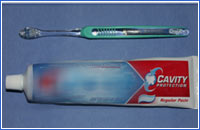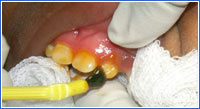Effects and Sources of Fluoride
Use of fluoride, both through dietary and topical applications, has led to dramatic drops in caries rates.
How Does Fluoride Help Prevent Dental Caries?
The topical effect of fluoride is more important than the systemic actions.
Topically, fluoride works by:
- Inhibiting tooth demineralization
- Enhancing remineralization
- Inhibiting bacterial metabolism
Systemically, fluoride works by:
- Excretion into saliva which flows onto the teeth, where it acts topically to strengthen enamel (see above)
- Reducing enamel solubility through incorporation into its structure during tooth development
What Are the Primary Sources of Fluoride?
Systemic Fluoride is obtained through:
- Water fluoridation
- Dietary fluoride supplements
Topical Fluoride is the most beneficial and is obtained through:
- Fluoride toothpastes
- Fluoride varnish
- Gels, foams, mouthwashes (for children 6 years of age and older)



References
Weyant RJ, Tracy SL, Anselmo TT et al. Topical fluoride for caries prevention: executive summary of the updated clinical recommendations and supporting systematic review. American Dental Association Council on Scientific Affairs Expert Panel on Topical Fluoride Caries Preventive Agents. J Am Dent Assoc. 2013. 144(11):1279-91.
American Academy of Pediatric Dentistry. Policy on use of fluoride. The Reference Manual of Pediatric Dentistry. Chicago, Ill.: American Academy of Pediatric Dentistry; 2024:101-3.